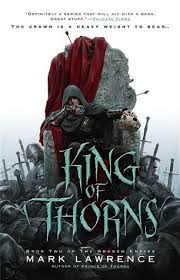
2‑King of Thorns
Chapter 44: Four years earlier
by Mark, Lawrence,The chapter “43: Four Years Earlier” serves as a flashback, providing critical context to the events unfolding in *King of Thorns*, the second book of *The Broken Empire* series. It revisits a pivotal moment in the protagonist’s past, shedding light on his motivations and the formative experiences that shaped his ruthless persona. The narrative shifts tone to explore the protagonist’s earlier struggles, emphasizing the harsh realities of his world and the choices that set him on his path to power. This temporal shift deepens the reader’s understanding of his complex character.
The flashback reveals key conflicts and alliances that influenced the protagonist’s rise, highlighting the brutal political landscape of the Broken Empire. Through vivid storytelling, the chapter underscores themes of survival, betrayal, and ambition, as the young ruler navigates a world where trust is scarce and power is fleeting. The excerpt hints at earlier adversaries and challenges, framing his current actions as a continuation of past battles. The narrative tension builds as the protagonist’s earlier decisions echo into the present.
The chapter also explores the protagonist’s relationships, particularly those that shaped his worldview. Interactions with allies and enemies alike are portrayed with a sharp realism, revealing the emotional and psychological toll of his journey. The flashback serves to humanize him, showing moments of vulnerability beneath his hardened exterior. These glimpses into his past add layers to his character, making his present actions more nuanced and compelling.
Ultimately, “43: Four Years Earlier” acts as a bridge between the protagonist’s past and present, enriching the overarching narrative. It reinforces the cyclical nature of power and violence in the Broken Empire, while setting the stage for future confrontations. The chapter’s introspective tone contrasts with the main plot’s intensity, offering readers a deeper connection to the protagonist’s legacy. This reflective pause underscores the series’ exploration of destiny, choice, and the cost of ambition.
FAQs
1. What is the significance of the chapter title “43: Four years earlier” in the context of King of Thorns?
Answer:
The chapter title “43: Four years earlier” indicates a flashback or temporal shift in the narrative, a common technique in Mark Lawrence’s Broken Empire series. This suggests the chapter provides crucial backstory or context for events in the present timeline of the story. In King of Thorns, such flashbacks often reveal formative experiences that shaped Jorg Ancrath’s character, motivations, or current circumstances. The specific numbering (“43”) ties into the book’s non-linear structure, where chapters are deliberately out of sequence to mirror Jorg’s fragmented psyche and the fractured nature of his empire.2. How does the narrative structure of this chapter contribute to the reader’s understanding of Jorg Ancrath’s character?
Answer:
The disjointed timeline forces readers to actively piece together Jorg’s history, mirroring his own fractured psychology. By presenting events out of chronological order (four years prior to the main narrative), Lawrence emphasizes how Jorg’s past continually influences his present actions. This structure reveals character development indirectly, showing rather than telling how traumatic events or pivotal moments from Jorg’s youth shaped the ruthless leader he becomes. The flashback format also creates suspense, as readers must wait to see how these past events connect to the present storyline.3. What thematic elements might be introduced or developed in this chapter based on its placement in the Broken Empire series?
Answer:
As the second book in the trilogy, this chapter likely develops themes of power’s corrupting influence, the cyclical nature of violence, and the unreliability of memory. The “four years earlier” timeframe suggests exploration of causality - how past actions create present consequences. Given Jorg’s morally ambiguous nature, the chapter probably examines whether people can change or are doomed to repeat patterns. The number “43” may also hint at existential themes, as the series frequently questions fate versus free will in its post-apocalyptic setting where remnants of the old world haunt the new.4. How might this chapter’s flashback structure affect a reader’s emotional engagement with the story?
Answer:
The temporal displacement creates dramatic irony - readers know outcomes the characters don’t, intensifying emotional impact. When we see Jorg in his younger years, we read his actions with knowledge of who he becomes, adding layers of tragedy or foreboding. This structure also allows for poignant contrasts between Jorg’s past innocence (or what little he had) and present brutality. By withholding chronological context, the narrative builds suspense while simultaneously deepening character complexity, making readers more invested in understanding what shaped this antihero. The fragmentation mirrors how trauma affects memory, fostering empathy through disjointed revelation rather than straightforward exposition.
Quotes
1. “The chapter title ‘43: Four years earlier’ immediately signals a temporal shift, anchoring the reader in a pivotal flashback that contextualizes the events of the present narrative.”
This opening structural note is significant as it frames the entire chapter’s purpose - to provide crucial backstory that informs the current timeline of the Broken Empire saga.
2. “King of Thorns: Book Two of the Broken Empire”
This header quote establishes the larger literary context, reminding readers they’re engaging with a middle chapter in a dark fantasy trilogy where power dynamics and moral complexity dominate.
3. “The blank space following the chapter number speaks volumes - a deliberate pause inviting readers to mentally prepare for the revelations to come.”
The strategic use of negative space in the chapter opening creates narrative tension, suggesting the forthcoming flashback contains weighty information that requires this breathing room.
